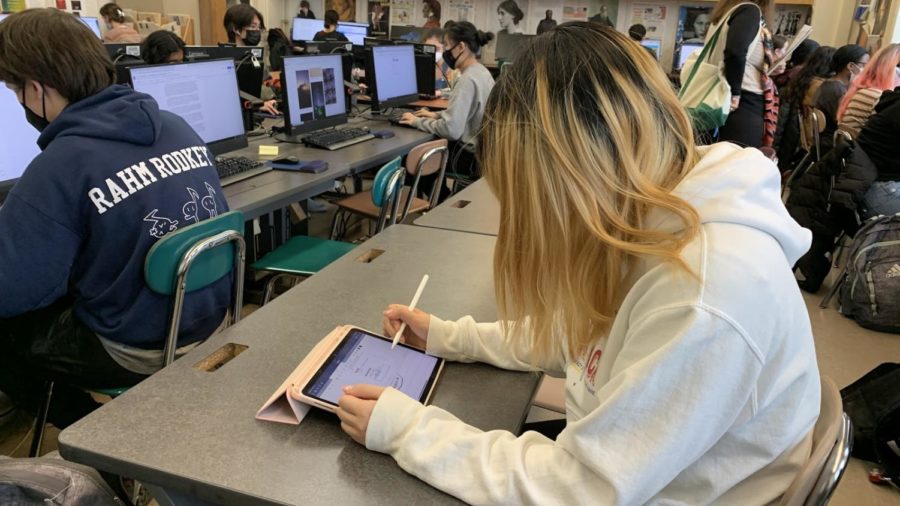iPads: Rec or Wreck?
Are iPads worth the money, or are they not worth the investment?
Melanie Lin ’22 uses her Apple Pencil, which not only has the benefits of a regular stylus, but is pressure sensitive, allowing users to control opacity and more with a flick of their wrists.
The popular TikTok influencer Keyon said, “Every time I see somebody whose life [is] together or is at peace in life, they’ve got an iPad.” Thousands of videos from others, posted under this audio clip, seem to agree — an iPad is the key to happiness and mental stability. But just how true is this? A thousand or so dollars seems like a small price to pay for a balanced lifestyle.
I’ve had my own iPad for a few years now. During the quarantine period at the beginning of the Coronavirus pandemic in the Spring of 2020, I started using it to take notes for my online classes, mostly out of laziness, I’ll admit. Taking notes on my bed was far easier, since I didn’t have to worry about a pen poking holes through the soft surface if I pressed a smidgen too hard.
Perhaps one of the biggest benefits is how small it is — an iPad is lighter and takes up far less space than most notebooks and binders. iPads are also much easier to organize, as many users who previously had trouble keeping track of their paper notes have noted. “I have the notes with me not just on [my] tablet but also on my phone,” Wendy Lin ’22 said. GoodNotes 5, the app that I currently use, allows users to create folders within folders, making organization even more straightforward. In real life, I typically have one two-pocket folder to cram all my handouts and exams into, but digitally, each of my folders can have as many “pockets” as I need. Whether you have one class or seven, you’ll have access to all of your notes in one place.
With an Apple Pencil and a Paperlike Screen Protector, writing on an iPad can feel almost exactly the same as writing on paper. For those who prefer typing, that, too, is an option with Apple’s Smart and Magic Keyboards. Magic Keyboards include a mousepad, converting any iPad into a laptop interface. This is arguably one of its most enticing features, allowing users to take notes in faster paced classes by typing and to copy down expressions and equations in mathematics using their Apple Pencil.
Digital notes are also easier to share and to back up. Unlike paper notes, if you accidentally spill water in your bag, you’ll have another copy safe and sound.
A downside of an iPad, however, is the battery life. Unlike traditional note taking with paper and pens, you have to charge an iPad every night, and on extremely long days, older models may run out of battery before the day is over. This may cause many inconveniences, especially if you’re not the best at remembering to charge your phone or devices overnight.
iPads are also quite expensive, with iPad Pros starting at $799 and the latest Apple Pencil model priced at over $100. This is definitely not a decision to be taken lightly, but a good investment if you’re looking to decrease your daily load as a high school or college student.
Like everything else, an iPad is far from perfect, but, in my opinion at least, the pros outweigh the cons, literally and figuratively.
“I have the notes with me not just on [my] tablet but also on my phone,” Wendy Lin ’22 said.
Ariana Ng is a Staff Reporter for ‘The Science Survey.’ She enjoys journalism because it allows for in-depth research and understanding of intriguing...











